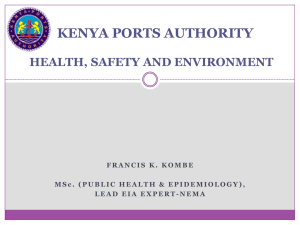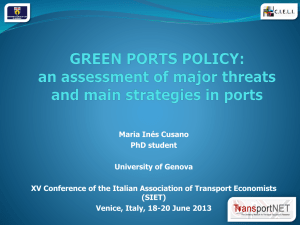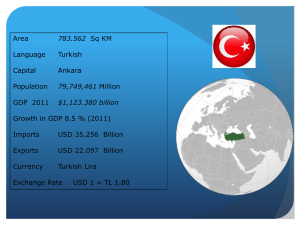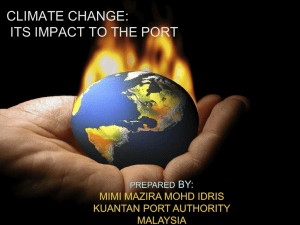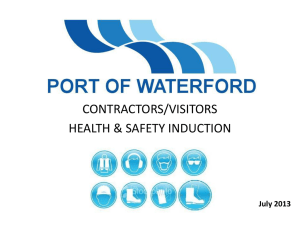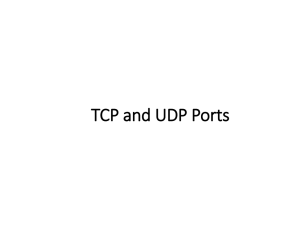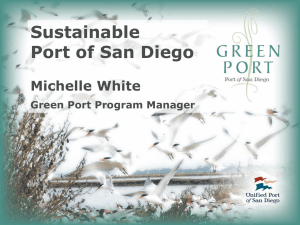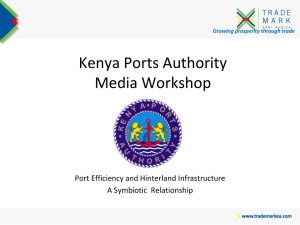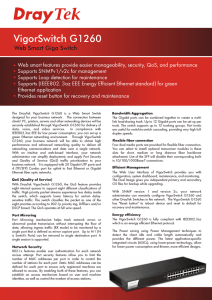SMART-PORT_Blue Energies
advertisement
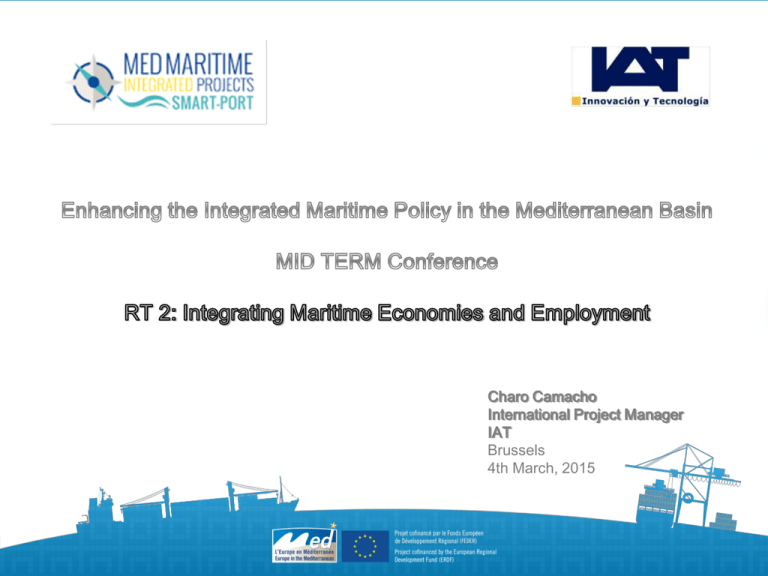
Charo Camacho International Project Manager IAT Brussels 4th March, 2015 1 3 Graphic Map of the SMART PORT key factors: defining the real challenge 2 Assessment on the current status of MED Ports on the bases of the SMART PORT trends “knowing where we are now it is essential to determine where we want to be” Map of Competitive Advantages and Disadvantages linked to the SP concept 4 Strategic Action Plan towards the SP concept, aimed at exploiting the existing potential and at the same time, contributing to the decision-making process In total 23 Criteria (and 68 KPIs) were defined for the assessment, 8 (16 KPIs) of them focussed on the energy performance of the selected ports: Valencia and Barcelona (Spain) Algeciras Bay (Spain) Piraeus (Greece) Genoa and Gioia Tauro (Italy) Maarsaxlokk (Malta) Genoa (Italy) Barcelona (Spain) La Spezia (Italy) Marseille (France) 1. Total consumption of energy 2. Energy consumption by containers 3. Energy consumption by internal fleets 4. Energy consumption by officesUse of renewables KPIs 5. In addition 2 non-med ports were Energy consumption by lighting1. % heating fuels from renewable analysed resources managed by the port authority due to their relevant influence in the Mediterrean area: Sines Energy consumption by terminals equipment 2. % heating fuels from renewable (Portugal) and Tanger Med (Morocco). for movement of containers 6. resources managed by terminal operators 7. Use of renewables 8. Energy Management 3. % energy from renewable resources managed by port authority 4. % energy from renewable resources managed by terminal operators. Great difficulty in assessing the current energy performance in seaports mainly because: The performance of the port infrastructure and services in terms of energy consumption is key for the its competitiveness and sustainability. ⇨ Port Authorities lack of a clear, exhaustive and updated overview of SP KPIs (with the exception of the operational KPIs). ⇨ ⇨ The challenge of energy efficiency has been taken up by port authorities, as many of them are Available data are often categorized according to different increasingly concerned with their emission profiles, protocols, units of measure and different time-scales and and regulation in port areas have become more frequencies. restrictive. In general terms, there is neither an exhaustive control about the energy consumption level in ports, nor about the costs that this consumption represents. Energy consumption is highly important in port operations. Bearing in mind the increase of energy costs, port authorities and terminals are ⇨ Port Authorities do not know about the energy performance needed of innovative solutions to reduce their fuel of the terminal operators in their facilities thus their integration bills. and coordination is not usual. Improvement intermodality Ports are not only a link within the logistics chain but a NODE where the operators interact of Better Energy High energy demand Management + and supply. further development throughout many of BE different processes processes: - simplifies the logistics chain - reduces cargo handling - improves safety But despite its potential this sector is facing several challenges which need to be faced: ⇨ Technology costs are high and access to finance is difficult; ⇨ There are substantial infrastructure barriers, such as grid connection issues or access to adequate port facilities and specialized vessels; ⇨ There are administrative barriers such as complex licensing and consenting procedures, which can delay projects and raise costs; ⇨ There are environmental issues to be faced, including the need for more research and better information on environmental impacts. Encouraging as potential among energy the suppliers, Promoting the coordination andports communication differentallowing them to sellwithin its energy surplus actors and operators the port area.in the grid (price policy regulation required). Better and Promoting the useto of green vehicles inside port area. improved access consumption and the energy Development R&Dtheand projects (RIS3, ESI, performance data and informationof(both, Port technology and its operators). H2020…) Definition of energy efficiency and performance indicators. Promoting (andofsupporting) the upgrading of ports facilities in Incentives towards the adoption energy management standards (ISO 50000). Embracing order to facilitate the production, manufacturing and distribution of ESIF H2020 and devices within the&port area Others (thus the technology smart components grid concept (EFFICIENCY encouraging the development establishment of these SUSTAINABILITY): promoting ports integration in and the Smart Grid companies in the port area). (generation and consumption). RIS3 Political incentives towards the use of renewable energies. Developing clusters and poles to push forward innovation and avoid National Programmes fragmentation. Improving access to risk capital or loans for startup SMEs; and improving intellectual property management. Increasing investments in demonstration projects (commercial feasibility); and large public-private partnership initiatives to gather the necessary critical mass. Promoting large PPP initiatives to gather the necessary critical mass Addressing legal and administrative hurdles. Charo Camacho International Project Manager rcamacho@iat.es Tel. +34 95 446 80 10 Fax: +34 95 446 04 07 http://www.iat.es C/ Leonardo da Vinci, 2 Isla de La Cartuja E- 41092 Sevilla. Spain


